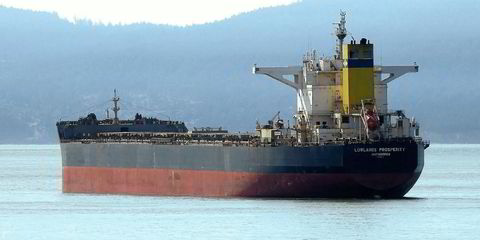Ship-vetting powerhouse RightShip has revised the algorithm behind its greenhouse gas ratings methodology for the first time in more than 10 years.
The main change consists of the influential player’s decision to neutralise the effect of operational measures — mainly engine power limitation (EPL) — from the factors it takes into account when assessing a ship’s environmental performance.
“As these measures can be overridden and are not inherent to ship design, RightShip employs the Admiralty principle to remove the effect of such measures on the rating,” the company said in a statement released on Wednesday.
In a further step, RightShip’s previous A-to-G rating system has been revised with a new one, called GHG 2.0 Rating, that ranges from A (best) to E (worst) to bring it in line with the pattern introduced by the International Maritime Organization’s Energy Efficiency Existing Ship Index (EEXI).
The new system and incoming EEXI data will upset, to a degree, clients’ current ratings, the company acknowledged.
“Some vessels may see their rating improve, while others will inevitably have their rating lowered,” RightShip said in the statement.
According to unofficial estimates, ratings for 80% of covered vessels will remain unchanged or improve, which suggests they will deteriorate for the remaining fifth.
“RightShip understands this is a cause for concern for those affected and is committed to supporting the sector through open dialogue and guidance,” the company said.
Design rules
RightShip managers went to great lengths to defend their decision to drop operational carbon reduction measures from the calculation. Such measures are accepted under the IMO’s Carbon Intensity Indicator (CII) rating system.
“We understand why some have called for the rating methodology to simply mirror EEXI,” said Jon Lane, RightShip senior sustainability manager.
“We have thought long and carefully about this and do not consider this to produce fair, ‘apples to apples’ comparisons,” he added.
“Of course, we encourage any measure that reduces emissions, including EPL, but we consider this to be an operational measure rather than one of design,” Lane said.
RightShip said it plans to make vessels’ operational measures data visible in the future when it will include ship CII data on its platform.
Rewarding investment
Work on RightShip’s updated methodology began last year in response to the IMO’s EEXI and CII regulations introduced in January 2023.
The company had guided the market about the impending changes. On its website, it said it wanted to “reward those who invest in decarbonisation through efficient design and energy-saving equipment”.
In its statement on Wednesday, RightShip’s GHG Rating product manager Man Mohan reiterated that goal.
“Our commitment at RightShip is first and foremost to a zero-harm maritime sector, and this is a vital step in reaching that goal,” Mohan said.






